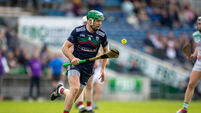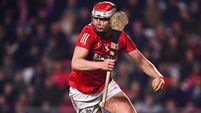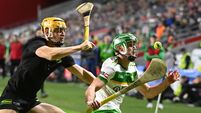Derek McGrath: Liam Cahill and Michael Bevans have added layers to the Waterford wall

Waterford’s Calum Lyons stops the run of Cork’s Mark Coleman during the Munster SHC semi-final in Thurles last month. While a lot has been said about Cork’s inept performance, not enough has been said about the energy, dynamism, and creativity of the Waterford approach, says Derek McGrath.
Waterford have decided to not let the outside in. Their healing and “reorientation” began when Liam Cahill was appointed and their “patience” can see them up the steps on Sunday next.
For many of the players, Sunday’s Munster meeting will represent their seventh big final in seven years. Having lost four of the five finals contested during my tenure, that sequence continued last year when we were defeated by Sunday’s opposition in the Allianz National League final.
Talk of bonus territory, nothing to lose, or a free hit, is an insult to this immensely proud and talented bunch of players. Column inches and opinion have centred on the ineptitude of the Cork performance in the semi-final rather than energy, dynamism, and creativity of the Waterford approach.
Cahill and Michael Bevans have the team and the supporters hunting as one. The Tipperary duo will be slow to call it anything other than work-rate and honesty of endeavour but the tactical nous and guile has seen Waterford return to doing what they are good at.
Sometimes I, more than the players, found myself at odds with the public perception around how Waterford play. An inclination to listen to the outside greatly affected our approach when we were on the wrong end of a Limerick pummelling in 2018.
Having played with real flow against Tipperary during the infamous ghost goal game, the week in Waterford was dominated by talk that it was “great to see Waterford play that way”.
We allowed the outside in and having prided ourselves on our detail when preparing, we chose the fairly conventional approach of a corner-forward coming no further than 40 yards with his man, a deep half-forward line, and Austin Gleeson holding the centre-back position.
With 12 minutes gone, Eoin Murphy turned to me and said, “Mac, please change to our extra midfielders shape”. A fairly orthodox approach had signed our own death warrant as Limerick withdrew all their players to the middle of the field and were eight points up as the proactive team.
Cahill and Bevans have quickly realised that the flexiblity and unorthodox nature of Waterford’s approach suits this bunch of players.
Waterford’s first use of an out-and-out sweeper during my term involved was in the 2017 All- Ireland qualifier against Offaly. Until then, we had developed from a system of playing one extra midfielder with an extremely deep half-forward line and midfield to two extra midfielders, often leaving only one or two forwards inside.
Both systems allowed our six — more often than not Tadgh de Búrca — to protect and patrol the D and occasionally pop forward to ‘give and go’ for a score.
Put simply, if you were part of the half-forward line, midfield, or one of the two extra midfielders, your job was to form a wall across the middle of the field with the instruction to hunt back and forward all day.
Like all systems, it is dependent on vicious savagery, huge athleticism, and the players at your disposal. One of the best training camps we held in Johnstown House involved the creation of a mini stadium in our games room where the 15 subs stood on the chairs around a simulated field.
Asking the seven players that formed the ‘Waterford Wall’ across the middle to hold hands, I challenged them: “Tell me how will Cork get past this wall”.
The idea was simple — that we would defend and attack in waves as one.
Despite this commitment to oneness, the pack mentality can sometimes lead to a grey area around marking and concession of scores, particularly to the opposing centre forward.
Central then and now is the mercurial de Búrca. Tadgh has often been the subject of lazy commentary and analysis. “Ah sure he has a handy one, sitting back and getting the ball thrown to him.”
That ignorance ignores his footwork, positional sense, distribution, and steely leadership.
Tadhg’s adaptability makes him a class apart. He has mixed and matched marking duties on TJ Reid, Conor Lehane, Shane Kingston, Bonner Maher, and Richie Hogan over the years, knowing when to mark and when to sweep, and crucially having the mental fortitude to know that concession of scores to his direct opponent does not outweigh the value he adds to both defence and attack.
Cahill and Bevans have added layers to the wall, in terms of the infectious enthusiasm, energy, and quality that Jack Fagan, Calum Lyons, Conor Prunty, and Dessie Hutchinson give. And they have cemented the wall by reinvigorating Stephen O’Keeffe, Kevin Moran, Jamie Barron, Austin Gleeson, and Darragh Fives.
Limerick will not have faced an energy and unorthodox formation like Waterford’s since they faced Dublin in the 2019 National League semi-final.
The Treaty men pride themselves on their KPIs, their metrics, particularly around the area of intensity levels, tackles made, and outnumbering opponents in key areas.
Waterford will have identified Cian Lynch, Aaron Gillane, Gearóid Hegarty, and Diarmaid Byrnes as players that can’t be allowed dictate proceedings. While one would expect Conor Prunty to be tasked with the Aaron Gillane project, other match-ups might be more left-field than people anticipate.
Tadgh, like Declan Hannon, will be instructed to do his own thing — marrying marking of his opponent when he comes into his area, with constant communicated handovers to Jake Dillon, Kieran Bennett, and the rest of the pack. I wouldn’t be surprised to see half-forwards Jack Fagan, Jake Dillon, and Austin tracking their opposite numbers Hegarty, Kyle Hayes, Lynch and Tom Morrissey.
The responsibility for Hannon and Byrnes will lie with Stephen Bennett, Jack Prendergast, and occasionally, will see Dessie Hutchinson’s hunt from inside.
Waterford may allow Limerick possession with Dan Morrissey and Sean Finn, rather than the creative playmakers in Hannon and Byrnes. Certainly the double-jobbing role of the modern forward line will never be more evident than in Thurles.
Waterford may keep Tadgh and one of Calum Lyons or Kevin back and leave the rest follow, mirroring Clare’s first 20 minutes against the Shannonsiders.
Tellingly, Waterford’s backs and midfielders scored 1-8 from play against Cork, compared with the forwards’ eight points — that underlines the effectiveness of this way of playing.
Jamie Barron’s footwork, size, and impish suppleness could trouble the more physically intimidating William O’Donoghue. Dessie Hutchinson’s match-up with Sean Finn will be intriguing and he, like Gillane, has the movement, footwork, and touch to win the ball in a one-against-three situation.
Having worked closely with Ballygunner, the role of Limerick analyst Sean O’Donnell will have been interesting. John Kiely and Paul Kinnerk will have considered the possible relocation of Kyle Hayes in the ‘lie up on’ centre-forward role he performed in last year’s Munster final, with the likes of Casey and Graeme Mulcahy buzzing out around the cordon.
Waterford will relish all the talk of Limerick’s physical supremacy. Whilst the role of S&C is hugely significant, physical commitment to the challenge ahead often lies in the mind.
I have been accused all week in school of being blindly loyal to this bunch of players with my prediction and Seamus Callanan rightly pointed out this week that “it will take a huge performance from any team to stop them (Limerick)”.
I believe it’s in our lads.
The Leinster final dynamic is no less interesting. Whilst talk centred largely on the physicality and energy of the Galway performance against Wexford, the understated calmness, confidence, and shrewdness that Shane O’Neill has brought to the table has been overlooked.
We were lucky enough to have Shane involved with our DRA hearing for Tadgh in 2017 and his professionalism, courtesy, and genuineness were infectious.
His sense of calm should not take from how planned Galway were against Wexford. Galway, like Waterford, will need to plan as cunningly for the Kilkenny, even if the Cats will field a more conventional formation.
Galway need to be as manic with their work ethic as they were against Wexford, but they also need to be as unorthodox.
Michael O'Donoghue's Galway were rightly lauded for their physicality and conditioning but they were well set up, often only operating with two forwards inside the 45. They mirrored this approach the last day with Jason Flynn and Brian Concannon inside.
Despite not scoring from play, Joe Canning was superb, combining selfless creation of space, impeccably timed offloads and radar accuracy from frees.
With freshness in the form of Fintan Burke, Shane Cooney, and the possible return of the Burkes, Galway should stick with the process of Conor Cooney and Joe turning up deep in their own back line.
It’s hard to believe that in all the debate surrounding Cork’s performances over the last number of years, in claiming the Munster Championships of 2017 and 2018 they have won more trophies than Kilkenny during that period.
Brian Cody will be aware Kilkenny’s mini drought will continue if their second-half performance against the Dubs is repeated. This will have served as the perfect catalyst for a refocus.
They will love the talk of Galway’s physicality, of their dominance and of the perception that they are the only team to possibly compete with Limerick.
Will Paul Murphy have found a way back into the full-back line? Will the two assassins Reid and Fennelly be deployed as per the Limerick semi-final last year, with perhaps Walter Walshlocated sporadically on the edge of the square or even in the corner as per the replay of 2012?
If Galway can hold the Ballyhale duo and if they bring the intensity and shape of the Wexford game, they can progress to a semi-final. Whilst we throw another block on the fire, all participants will put it all on the line, vulnerabilities included.
We live to be involved in such days and as Madeline L Engle said: “To be alive is to be vulnerable.”







